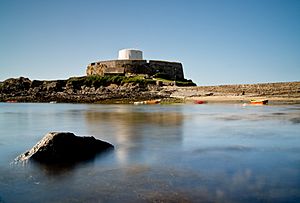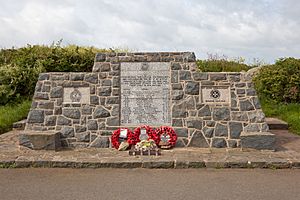Fort Grey facts for kids
Quick facts for kids Fort Grey |
|
|---|---|
| Château de Rocquaine |
Fort Grey is a historic tower located on a rock in Rocquaine Bay, on the west coast of Guernsey. People often call it the "cup and saucer" because of its unique shape. This building is a type of small, round fort known as a Martello tower.
Contents
The Old Castle of Rocquaine
Before Fort Grey, there was an older structure on the same rock. It was known by its French name, Château de Rocquaine, which means "Castle of Rocquaine." In the local Guernésiais language, it was called Châté dé Rocquoïne. This castle was likely built a very long time ago, during the Late Middle Ages.
By the 1620s, the old fort was used by local soldiers, but it wasn't strong enough to defend against attacks. In the 1500s, some people believed this spot was a meeting place for local witches. In 1617, there were stories about a local girl, Isabel Becquet, meeting with what people believed was the devil.
Building Fort Grey
The Fort Grey you see today was built on top of what was left of the old Château de Rocquaine. Its distinctive white tower was constructed by the British in 1804. This was during the Napoleonic Wars, a time when Britain needed strong defenses. A local builder named Thomas Henry from Clos du Valle was in charge of the construction.
The fort was named after Charles Grey, 1st Earl Grey, who was the Governor of Guernsey from 1797 to 1807. Fort Grey was one of three places on the island where a warning gun would be fired if an invasion was expected.
Martello Towers in Guernsey
Fort Grey is a Martello tower, similar to Fort Saumarez and Fort Hommet in Guernsey. These towers were designed to be strongholds for the gun batteries they protected. The Martello towers in Guernsey are generally smaller than those found in Britain. Fort Grey's tower is a bit larger than the ones at Fort Saumarez and Fort Hommet.
Each of these towers had a powerful 24-pounder carronade (a type of short cannon) mounted on its roof. This cannon was used to protect the surrounding battery. Fort Saumarez and Fort Hommet also have outside staircases leading up to their second floors.
Around 1808, the road connecting St Peter Port to Fort Grey was improved. It was made stronger for military use, using money from the sale of land that had been reclaimed from the Braye du Valle.
Fort Grey in World War II
In 1891, the War Office in London sold Fort Grey to the States of Guernsey for £185. Later, during World War II, the German forces occupied Guernsey. They took over many of the island's fortifications, including Fort Grey.
The Germans renamed the fort Widerstandsnest Graur Turm, which means "resistance nest Gray Tower." They armed it with a mobile 3.7 cm Pak 36 anti-tank gun and machine guns to defend against attacks.
Fort Grey as a Museum
Today, Fort Grey has a much more peaceful purpose. It operates as a local shipwreck museum. Inside, you can find many interesting items that have been recovered from famous shipwrecks around Guernsey.
Some of these items come from ships like the MV Prosperity and the Elwood Mead. There's also a cannon from HMS Boreas. This cannon points towards the nearby Hanois rocks, where the Boreas sank in 1807. Many lives were lost in that shipwreck, including the ship's captain.
A special exhibit of wooden timbers from a 3rd-century Roman ship, nicknamed "Asterix," is also on display nearby. These ancient timbers were discovered in St Peter Port harbour in 1982 and took many years to preserve. They are now 1,700 years old!
Protecting Fort Grey
The entire Fort Grey building and the nearby slipway at Rocquaine were officially listed as a Protected Monument on March 26, 1938. This means they are important historical sites that are protected by law.




